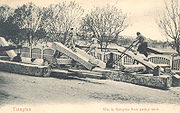
Two-man saw
Encyclopedia


Saw
A saw is a tool that uses a hard blade or wire with an abrasive edge to cut through softer materials. The cutting edge of a saw is either a serrated blade or an abrasive...
designed for use by two sawyers. While some modern chainsaw
Chainsaw
A chainsaw is a portable mechanical saw, powered by electricity, compressed air, hydraulic power, or most commonly a two-stroke engine...
s are so large that they require two persons to control, two-man crosscut saw
Crosscut saw
A crosscut saw is a saw that is specially designed for making crosscuts. A crosscut is a cut made horizontally through the trunk of a standing tree, but the term also applies to cutting free lumber...
s were primarily important when human power was used. Such a saw would typically be 4 to 12 feet long (approximately 1.2 to 3.6 metres), and sometimes up to 16 feet (4.9 metres), with a handle at each end. In some cases, such as when felling Giant Sequoias, sawblades could be brazed
Brazing
Brazing is a metal-joining process whereby a filler metal is heated above and distributed between two or more close-fitting parts by capillary action. The filler metal is brought slightly above its melting temperature while protected by a suitable atmosphere, usually a flux...
together end-to-end in order to create longer saws.
The technique in using a two-man saw involved a sawyer standing at each end. Together the sawyers would alternate pulling the saw through the wood. If the kerf
Kerf
Kerf and similar can mean:* kerf, the width of a cut* Kerf, a poetry collection by Peter Sanger* Kerala E.N.T. Research Foundation , a hospital at Kollam in Kerala in India...
begins closing, which can cause the saw to bind, wedges could be inserted in order to keep it open. Cutting from underneath a suspended log, called "underbucking
Underbucking
Underbucking is a type of log bucking. Underbucking is cutting upwards from the bottom of a suspended log.An underbucking tool can be made using an ax driven into the side of the log so that a crosscut saw can be turned upside down....
", might also have been used if binding became a big problem.
Many variations on the design were used, but they mainly fell into two types. Felling saws were used to fell the trees, and bucking
Log bucking
thumb|right|Bucker measuring and swamping or knot bumpingthumb|right|Bucker - Making the CutBucking is the process of cutting a felled and delimbed tree into logs...
saws were used to cut felled trees into lumber. The two applications require slightly different designs: a felling saw has a narrower blade, allowing wedges to be more easily inserted, while a bucking saw has a wider blade, giving it more strength.
Two-man saws were designed to cut in both directions. Careful tooth design was necessary to clear the sawdust during the cut.
Two-man saws were known to the ancient Romans, but first became common in Europe in the mid-15th century. In America, crosscut saws were used as early as the mid-17th century, but felling saws only began to replace axes for felling trees in the late 19th century. Some Japanese saw
Japanese saw
The Japanese saw or ' is a type of saw used in woodworking and Japanese carpentry that cuts on the pull stroke, unlike the European saw that cuts on the push stroke. This allows it to have thinner blades that cut more efficiently and leave a narrower cut width...
s are used by two persons, although they are of a different design.

